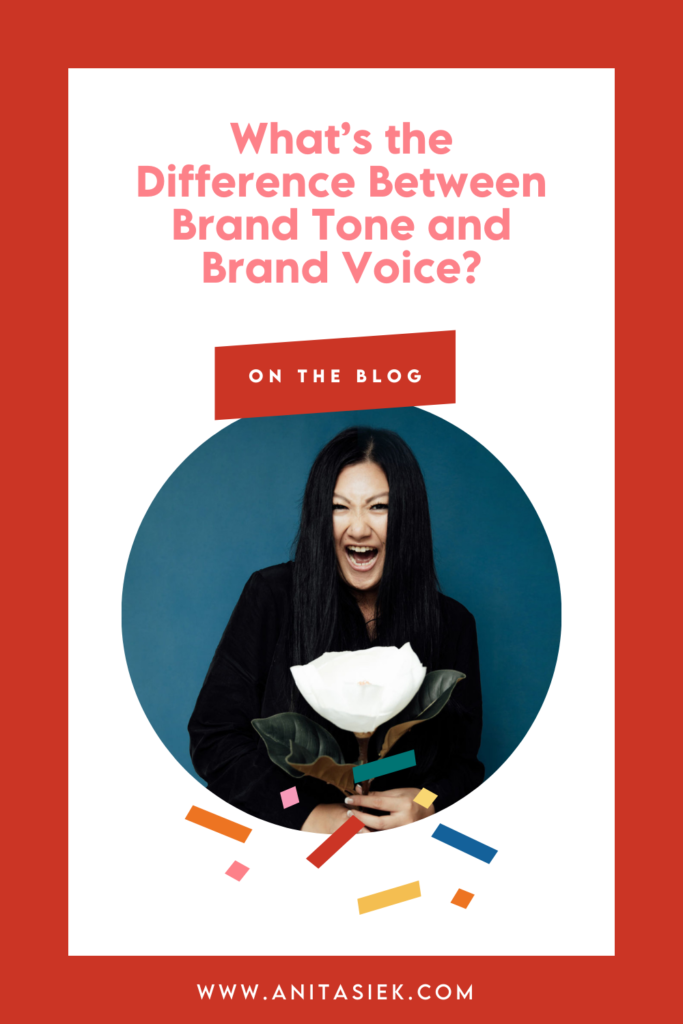The Anita Siek Blog
The Brandfetti Podcast
The Wordfetti
Shop
Podcast
Personal
Content Magic
Business
Lawyer (yep-a-dee-yep, I used to write things people never read) turned Brand and Copy Strategist, and Word-ucator for brands like you, who want to ZIG when others zag.
Hi, I'm Anita!
What’s the Difference Between Brand Tone and Brand Voice?

Photo credits: @mattcrump
Podcast Shownotes (Bullet)
- Are you one of those people who seem to write an Instagram caption but it does not sound right?
- Key differences between tone and voice.
- Tip #1: Do not develop a brand voice based on what you think is going to sound cool.
- Tip #2: Get clear on your mission and your values.
- Tip #3: Articulate your brand personality first and develop your voice second.
- Carl Jung Principles: Brand personalities for brands
Podcast Shownotes (Timestamps)
02:00 – 02:41: Are you one of those people who seem to write an Instagram caption but it does not sound right?
03:01 – 07:54: Key differences between tone and voice.
07:58 – 09:38: Tip #1: Do not develop a brand voice based on what you think is going to sound cool.
09:39 – 11:08: Tip #2: Get clear on your mission and your values.
11:19 – 12:28: Tip #3: Articulate your brand personality first and develop your voice second.
12:29 – 14:05: Carl Jung Principles: Brand personalities for brands

Do you know what I’ve found consistently through talking to our audience and working with our clients? That for quite a bit of us – we know what we want to say, but where do we struggle?
We don’t know how to say it.
Are you one of those people who write an Instagram caption only to start backspacing cause you have started to question whether or not that “sounds” right or whether or not this is on brand?
Well then? This is for you. Cause we are going to dive into the key difference between Tone and Voice, and I’ll also share with you some tips as to what you should consider when you craft your voice and your tone.
First of all though – let’s take a step back by answering the question of what exactly is a tone of voice?
To answer that, we’re going to have to take an additional step back and start answering what is a “voice” when it comes to a brand.

Brand Voice
The voice of your brand refers to the character and personality of your brand. Think of your brand as a person for a moment.
Your best friend.
Your cousin.
Your family friend.
If we were to give them a topic on say – the colour yellow – all of them may talk about it but based on their personality. Whether that be easily excited, super passionate about the colour yellow or reserved, their personality will govern their behaviour when this topic is raised.
That’s the foundation of a brand voice. They can potentially change throughout the years, but their values are in a way, cemented and potentially predictable. It’s not so much about HOW a brand talks, but more about HOW it behaves.
A lot of the time we connect and become friends with those whose behaviour and personality align with ours. And a brand’s voice? Should be consistent across all of your brand’s touchpoints be it in person, through email, captions, email marketing. And it is through this consistency in Voice that your brand will eventually develop a recognisable and distinctive personality.

Tone
On the other hand, your tone is the emotions, the expression or the mood.
For example, how you speak to Mark Zuckerberg would be different to how you speak to a friend about your work. This is why you will find your tone should change depending on the objective of your content, the context, the audience you are in front of and potentially the situation.
And they must change because this conveys empathy.
So as an example, you can have a brand personality or voice that is a bit playful and potentially a bit of a joker. You know. You’re a bit humorous but not silly, and you don’t take life too seriously.
While these are the underlying principles of your brand personality – when faced with for example the tone you use when a client makes a purchase (where you are cheerful, cheeky and excited) versus a client who hasn’t received her order (where you would then be brief, articulate and a provider of solutions) would be different.
Bringing the two together brings you empathetic copy, the ingredient that will help your audience feel heard, and respected.
Some amazing reiterations I’ve seen of this include seeing voice as the climate, and tone as the weather. And to see voice as the record, and the tone as the songs on that record.
Voice are the underlying thread. While the tone is an expression of this underlying thread that can be varied depending on the situation.
So what are some tips for you to take away in terms of your brand’s voice and tone?

#1 Do not develop a Brand Voice based on what you think is going to sound cool.
This is one of the biggest mistakes I see brands make. They develop a brand personality or Brand Voice based on what they think sounds “cool” or based on what a competitor of theirs is doing. Nope. Don’t do that.
When developing a brand voice, remember to stay in your own lane. Of course, have a look and see what your competitors are doing – but do that so that you can craft a brand voice that is distinctive from them and not have you blend in.
The second part of this is the fact your brand voice should be developed based on your audience and the feel of your brand. Because at the end of the day? They’re the ones who will be handing over their credit card to you.
And while your uber supportive Aunt Patricia may love what you do, it’s not so much about what brand voice she likes.
This is probably another reason why I always have a silent cringe when you go to a Facebook group and someone asks for an opinion on their tone of voice, or even their logo. These may not be your people, so don’t ask them.

#2 Get clear on your mission and your values
For us at Wordfetti, we do not craft a brand personality or voice until we have articulated the brand’s mission and values. Because your personality, tone, and voice should all align and reflect with your purpose, mission and what you stand for.
For example, Mailchimp, their website says its mission is to help small businesses succeed and grow. So it would make sense that they have crafted a voice that is warm, helpful, human and familiar.
On their website they have actually published their voice (I suggest you all have a look at it) where they go further to say they are fun but not silly, confident but not cocky, helpful but not overbearing, expert but not bossy, weird but not inappropriate which all go back to the feeling they want to convey of being useful and welcoming.
This is a GREAT exercise for you to do. A what we are. What we are not.

#3 Voice first Tone second
Articulate your brand personality first, and develop your voice second. This should stay consistent and this should also align with your brand mission and values.
Remember, your brand voice is the personality. This should be consistent.
And the tone of your emotional expression has to be adjusted based on your message, context or audience.
There you have it. Voice vs Tone.
Want some more copy wisdom, straight to your ears? Listen to the Brandfetti podcast wherever you get your podcasts.
Want to get more copy, brand and content tips? Listen in on Brandfetti and follow me here and the team here.

Check out these popular posts


